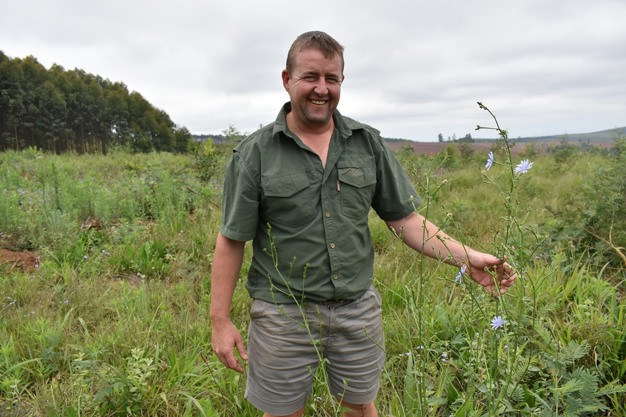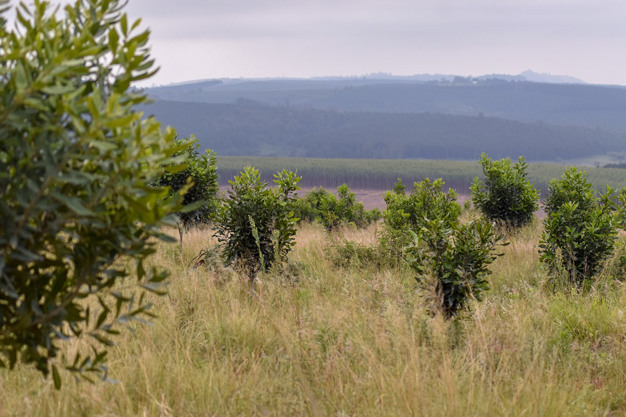“The other day,” remarks Henry Hopkins, macadamia production manager at the MTO Group, “I got a message from the farmer across the road to say: what you’ve done in your orchards looks pretty good. That’s nice to hear. Because to me, and the way I was trained, it looks untidy. We were used to everything slashed and clean under the trees before. Now you farm ‘dirty’ because there’s no other choice: we have to start giving back.”
Primarily a forestry company, the MTO Group acquired macadamia trees on various farms in the White River district since 2017. After dehusking (the husks make a rich compost, Hopkins notes) and drying, the nuts are delivered to Golden Macadamias, a wholly grower-owned marketing company of which they are shareholders.
MTO macadamia orchards and plantations against the backdrop of the Klipkoppies Dam, Nelspruit
At the time of the original acquisition MTO had only 42ha of macadamia orchards. It has since been expanded with the planting of a further 316ha, which last year exceeded expectation with a harvest of over 200 tonnes.
When Hopkins joined MTO, having worked for a banana grower and a citrus grower as well as for Hygrotech seeds, the macadamia orchards were on bare (‘clean’) and cracked soil, despite the farms’ location in the verdant mist belt of White River.
That’s not the way they do it anymore. “You have to realise you don’t actually farm with trees, but with soil. And if we can sort out the soil, and it is healthy, my tree will be healthy and I’ll get a good crop.”
To that end, forbs and grasses blanket the open spaces in orchards and every tree is encircled by mulch, worth its weight in gold: some of the trees were only watered upon planting three years ago.

Henry Hopkins with chicory, part of the veld mix for bee forage sown around young macadamia saplings
Rhodes grass, commonly used to colonise disturbed soil, and guinea or buffalo grass, are both nutritious to grazers like the wild buck frequenting orchards in the Lowveld. There is a no-shoot policy of wild animals on MTO land. When the sorghum and babala grasses are in seed, it’s “chaos” in the orchards when seed-eating birds descend.
“Where we would apply glyphosate four or five times a year to suppress weeds, if we now spray twice a year it’s a lot,” he says. “In the areas that were compacted and cracked, we reduced the slashing and I just waited for seed to disperse and cover the soil and today those bits are almost fully grown over.” And as they remove eucalyptus and re-establish veld amongst young macadamia saplings, forgotten perennial streams re-appear, draining down to the Klipkoppies Dam, a favourite among anglers. Hopkins mentions recently guinea fowl also re-appeared.
And as they remove eucalyptus and re-establish veld amongst young macadamia saplings, forgotten perennial streams re-appear, draining down to the Klipkoppies Dam, a favourite among anglers. Hopkins mentions recently guinea fowl also re-appeared.
Right: a perch for raptors erected in a macadamia orchard
Black wattle seed can remain in the soil for seventy years, and even though MTO has not had black wattle on these slopes in recent years, if left untreated or unplanted, young trees are swiftly choked by wattles and weeds, especially given the area’s high rainfall of around 1,200mm per year.
The plan could include a herd of cattle in future; they can generate a substantial amount of grazing in between several hundred hectares of young macadamia trees.
Year-round bee forage
But the main reason they wanted to introduce biodiversity to the orchards was to feed bees year round, who could then permanently reside there. “Our opinion is that you can’t avoid bees getting stressed when they are moved around. Currently we have 200-odd permanent hives on the farms. Bees need to be able to live here year-round.”
Chicory (Cichorium intybus) is very useful for the purpose, as is Plantago, another forb commonly disregarded as a weed but a favourite among bees. Low herbs offering bee forage as complemented by locally indigenous trees like Schotia (boerboon) and Syzygium cordatum (water berry).
Birds flock to the diversity offered by the open orchards
Dr Schalk Schoeman, an entomologist employed by the macadamia industry, gets really excited by the turning tide he is witnessing among Lowveld fruit and nut farmers. He has arranged for the re-introduction on MTO’s farms of an aloe on the brink of extinction, Sim’s aloe (Aloe simii) – so endangered that construction of a road was delayed by several years pending the outcome of a propagation trial of the aloe.
“We try and give back as far as possible,” Hopkins observes. “When I listen to all the insects and birds singing in our orchards and I look at how our trees are growing under dryland conditions, I think everything we're doing is really working.”

 For more information:
For more information:
Henry Hopkins
MTO Group
Tel: +27 13 590 0530
Email: info@mto.group
https://www.mto.group/
